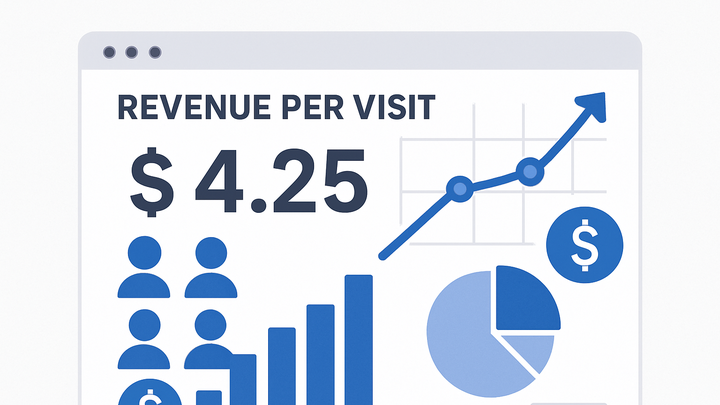Published on 2025-06-22T05:06:35Z
What is Revenue per Visit? Calculation, Examples, and Optimization
Revenue per Visit (RPV), sometimes called Revenue per Session, is a web analytics metric that measures the average revenue generated per visit to your website. It is calculated by dividing total revenue by the number of sessions in a given timeframe. RPV provides normalized insights into how effectively you monetize traffic, enabling fair comparisons between channels, campaigns, and audience segments. Unlike aggregate revenue figures, which can be skewed by a few large transactions, RPV highlights the average value each visitor brings. This metric is vital for e-commerce, subscription services, and ad-supported platforms focused on maximizing monetization. By tracking RPV in tools like Google Analytics 4 (GA4) or PlainSignal, analysts can identify areas for UX improvement, targeted marketing, and pricing experimentation. Improving Revenue per Visit ultimately drives higher profits and supports strategic growth.
Revenue per visit
Average revenue generated per website visit, calculated as Total Revenue divided by Total Visits.
Definition and Formula
Revenue per Visit (RPV) quantifies the average revenue each session contributes. It offers a normalized view of monetization efficiency, enabling performance benchmarking across different traffic sources.
-
Revenue per visit formula
Revenue per Visit is calculated by dividing total revenue by the total number of visits (sessions) during the same period.
-
Total revenue
The aggregate amount of revenue generated from all transactions on your site in the analysis period.
-
Total visits
The total number of sessions or visits to your website during the analysis period.
-
Why Revenue per Visit Matters
RPV reveals the average value each visit brings, offering deeper insights than aggregate revenue alone. It helps businesses optimize marketing spend, improve user experience, and prioritize high-value traffic.
-
Assessing visitor quality
A higher RPV indicates that visitors are more engaged and likely to complete revenue-generating actions, guiding acquisition and retention strategies.
Calculating Revenue per Visit in GA4
Google Analytics 4 provides built-in monetization reports to track revenue and session metrics. You can view RPV directly if available or calculate it manually using exported data.
-
GA4 monetization reports
Navigate to Reports > Monetization > Overview to access revenue and session data. If RPV is not displayed, export total revenue and sessions and divide them to compute the metric.
-
Enable e-commerce tracking
Activate Enhanced E-commerce in your GA4 property to collect detailed transaction and revenue information.
-
Data export
Export revenue and session metrics via the GA4 API or Google Sheets connector to perform custom calculations.
-
Implementing Revenue per Visit Tracking in PlainSignal
PlainSignal is a cookie-free analytics solution that can capture revenue and visit data needed for RPV. Setup involves adding preconnect and script tags and sending revenue events.
-
PlainSignal setup
Insert the PlainSignal tracking code into your site’s head section and configure revenue event tracking.
-
Add preconnect tag
Include this in your <head> to optimize performance:
<link rel="preconnect" href="//eu.plainsignal.com/" crossorigin /> -
Insert script tag
Add the PlainSignal script with your site ID:
<script defer data-do="yourwebsitedomain.com" data-id="0GQV1xmtzQQ" data-api="//eu.plainsignal.com" src="//cdn.plainsignal.com/plainsignal-min.js"></script> -
Send revenue events
Use PlainSignal’s JavaScript API or data attributes to report transaction revenue on purchase confirmation pages.
-
Best Practices and Optimization Strategies
Improving RPV involves a combination of user experience enhancements, targeted marketing, and iterative testing. Regularly monitor trends, segment audiences, and experiment with adjustments to maximize revenue per session.
-
Optimize conversion paths
Streamline checkout flows and reduce friction points to increase completed transactions.
-
Personalization and segmentation
Tailor content and offers based on visitor behavior, demographics, or referral source to increase average spend.
-
A/b testing pricing and ux
Experiment with different price points, promotions, and layouts to discover combinations that boost RPV.
